 |
[May 5th 2006]
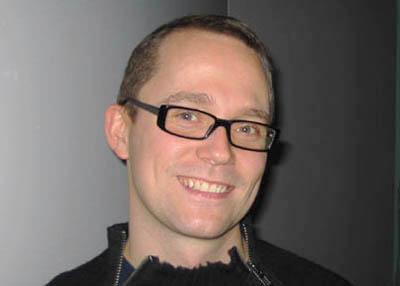
Marius Watz
10*10
10 questions for 10 Nordic artists
Current artist: Marius Watz
Artificial set out to dig an alternative route through the activities on the Nordic scene for computer based art. We wanted to find a way to sidestep the restrictions in our own particular outlook so we are therefore launching an unpredictable series of interviews, which will hopefully help us uncover the hidden potentials out there.
Initially we handed Norwegian artist Trine Eidsmo a set of 10 questions and she passed them on to an artist of her choice. After answering the same questions, this artist chooses a new artist ... and so forth. The only criterion for the participants are that they live and work in Scandinavia and create computer based art. In the end, 10 Nordic artists will have answered 10 questions about their art, working process and much more.
The latest artist in the series was Finnish artist, Juha Huuskonen, who handed the questions to NorwegianMarius Watz. Here is what he answered.
What is your background?
I am an autodidact, with no formal training in art, design or art history. I'm a first-generation computer geek, I got my first computer when I was 11 and started coding straight away. But it wasn't until I was 20 that I realized I could use code to create visuals. I was involved in the Oslo rave scene at the time, and dropped out of my Computer Science studies to follow my instincts, trying to create something new by combining programming with graphic design.
I have always had an interest in both art and design, with a strong connection to the pop culture. The whole spectrum of electronic music is also essential an essential reference. In the mid-90s I was involved in big media art projects, I was part of the curator team who put together the big Electra exhibition in 1996, and I worked on some large-scale interactive installations. After that I lost interest in the art world for several years, pursuing design instead. 4 years ago I realized I had lost interest in design processes, so I moved to Berlin to focus on my own work again.
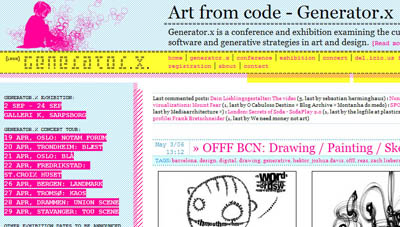
In 2005 I started the Generator.x project, which quickly grew into a complex platform for generative art and software-based artistic expression in visual arts, design and music. So now I'm a curator as well, I guess.
Describe your working process.
I'm your basic mad professor, locked up in the tower with my machines, lightning flashing across the sky. I don't collaborate or work in groups, so when I have to create a new piece I usually shut myself off from the world, trying out different code structures until something interesting comes out. I use no raw material except code, no analogue “original”. Usually, I hardly even sketch. I will start with a technical description of the final output format and develop a solution that fits it, relying on intuition to guide me.
Do you solve your technical issues yourself (do you e.g. program yourself) or do you rely on the cooperation with a programmer or a technician?
I code all my own work, but I make extensive use of Open Source materials for basic tasks. Reinventing the wheel makes no sense. I try to give back to the community when I can, making tips and source code available if I figure out something useful. I'm a decent coder but not a genius, so I rely on a community of peers to provide answers when I'm stuck on a technical issue. If I do need an external technology that I don't master, say physical interfaces or lighting devices, I will of course seek help. But I never farm out the core creative programming, since that is where the artistic work is created.
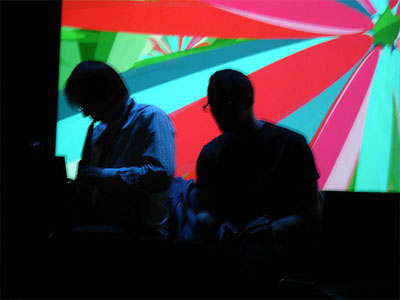
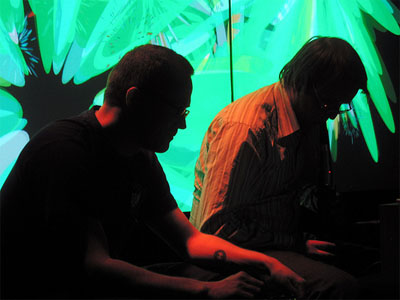
Generator.x Tour. Phonophani aka Espen Sommer Eide on vocals, MIDI clarinet, Max/MSP and Tandberg public speaker system
Marius Watz on generative sound-responsive visuals.
In which way do you describe your art?
I am a visual hedonist, working with organic visual abstractions through generative systems, implemented as software. My work is graphic, bold and colorful, without representational ambitions. I am all for the decriminalization of ornament. More is more, too.
I make no explicit attempts to formalize or conceptualize my work, I leave it to the viewer to make connections. It might look like commercials for alien bubble gum, but that doesn't mean I don't have strong ideas or that I don't explore an internal logic in the work. It just means those ideas are not made explicit, nor are they a necessary explanatory component for the viewer's appreciation. Generative artists are often asked if showing the code is important to them, and I would say no. It is of course there as a conceptual background, but the code is not the work, it is just the genotype. The software compiled and executed is the work realized.
How would you describe the relation between computer based art forms and the traditional art forms?
There is no single clear relation, these days the computer can mimic or take an assisting role with most of the traditional art forms, including painting. But I think many artists (and designers) who work with digital media are rediscovering the issue of craft, both in terms of attention to detail and as a way to get closer to the medium. That is certainly true for artists working with computational media.
Creating with code can be like working with a material, albeit a constantly morphing one. Algorithms have their own material qualities, one might feel liquid, another rigid. One solution might be delightfully unstable, another can provide just the right control. When coding you are very “close” to the work, sometimes you can almost physically sense the dynamic qualities of an algorithm.
Which role should art institutions and galleries play in regards to work like yours?
The 'ghetto' of media art festivals and specially themed exhibitions in continental Europe and overseas remain my most important venues. Museums and galleries in the Nordic region are largely not concerned with electronic art, being either too conservative or too limited in their interests. This is despite the fact that experiences show that this kind of art potentially resonates with broader audiences who are both fascinated and frustrated by technology.
Electronic art has a strong relationship to popular culture through music, games etc, but again this is largely ignored by the institutions. As a result, electronic artists often show in outsider spaces or temporary arenas like festivals. Similarly, it is not included in permanent collections of contemporary art museums etc. The exception of course is video art, but the computer-based arts are almost uniformly ignored.
I expect that generative artists will eventually find access to the gallery market, as their work is relative easy to package as art objects. For my own art this would be certainly be possible, but I haven't explored that venue just yet. To cross over into gallery shows means solving the problem of how to sell limited editions of an infinitely reproducible product, in order to make it palatable for collectors etc. I am curious to see how this develops.
Which exhibition form do you regard as ideal for your art?
I have done several large-scale projections either for public space or indoors, which works very well with the organic quality of my visuals. Scale is important, enabling the viewer to experience the image on an architectural level. To transform an entire venue into a plastic visual space is extremely gratifying. Since my systems often evolve over time without repetition they also work well in public space. This allows the exploration of generative visual systems as ambient information, developing slowly and adding a dynamic aspect to the space.
Going in another direction, my works have a potential for detail that can't always be explored in projections. I will produce prints of my work for the first time for an exhibition in Turin in June. I look forward to exploring print more.
How would you describe the situation on the Nordic scene for computer based art?
I have to qualify my response by first admitting that I rarely work within the Nordic scene, so I may have a distorted view of it. Nevertheless, I find the scene incoherent and often lacking in mutual support. Events like Electrohype 2004 (now sadly likely not to be repeated) and Trondheim Matchmaking have been the exception, in bringing together representatives from the whole region. With Generator.x I have tried to bring in artists based in the Nordic region, but there are not that many generative artists working here. The conference did show that there is a definitive interest in code as a creative tool, but I think we are a few years away from a realized scene.
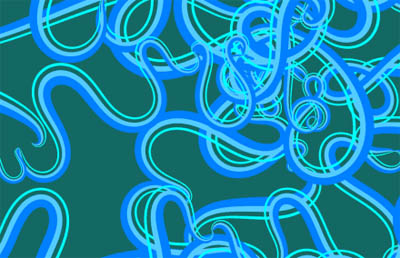
System_C. Marius' generative drawing machine. Shown at - among many other places, Electrohype 04.
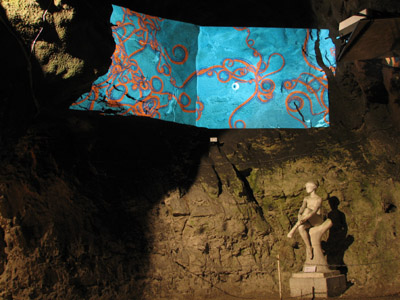
System_C shown at the MINE exhibition in DK, fall 05
The scene in Norway is currently quite good, with continued support from the government for network-building projects like BEK, TEKS, Atelier Nord and PNEK. But even here the network often fails, with the individual nodes rarely supporting each other's projects.
How do you support yourself financially as a digital artist?
I am privileged to be able to live from my work most of the time. As an electronic artist you are paid for exhibiting, even if it often is a nominal amount. This financing model is more like that of a performing artist, you get paid per gig etc. This income I supplement by giving workshops, and doing occasional commissioned pieces. Unlike many Nordic artists I don't usually apply for money for project support, even though that could probably be an income source. For now I find it too restrictive to have to plan out a whole project in advance. As a curator I use the funding system where relevant.
What are you working on now?
I have just finished a concert tour with Generator.x, touring with Frank Bretschneider, Lia, Emi Maeda and Phonophani. For the tour I developed a new visual performance system for my performances with Phonophani, which was a welcome challenge. I am also planning future Generator.x events, a lot of effort went into creating that platform and I intend to get a bit more mileage out of it by organizing events outside of the Nordic region.
Personal projects for the near future include doing a workshop and exhibiting at the OFFF festival in Barcelona in May, creating prints for the exhibition 'c.stem' in Turin in June and several new projection works. I will be doing a two-month residency in Vienna this summer, as part of which I will co-curate an exhibition of generative art with Sandro Droschl at Medienturm in Graz. There is also a show in Sao Paulo in July, which I am excited about.
Read other Artificial articles with Marius Watz:
Interview with Marius Watz, 2005
Images from the MINE exhibition, 2005
Images from the Electrohype Biennial 2004
5 Faves picked by Marius Watz, 2004
|
 |
|